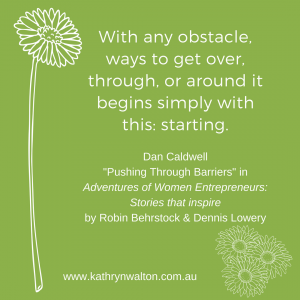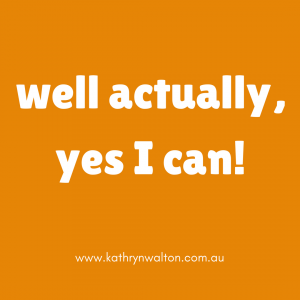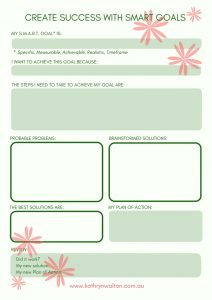Whether you’re a visitor or a local, there are plenty of choices when it comes to walking in the Southern Downs. The region is about 1 ½ to 2 hours south west of Brisbane in Queensland. The two main urban centres are Warwick and Stanthorpe, with dozens of smaller rural towns and villages across the region.
This post is an overview of just some of the many walks you can choose from. Keep an eye out for future posts that will give you heaps more detail on a selection of the bushwalks and mountain bike trails in the region like the one I wrote last year on Bushwalking in Goomburra, Main Range National Park.
Thinking about taking up hiking? My blog post How To Get Started Bushwalking will get you going!
Walks in and around Warwick
Queen’s Park River Walk

The Southern Downs region promotes 5 different urban walks close to the Warwick CBD which you can follow along on this map. The popular River Walk at Queen’s Park has recently been extended past Hamilton Oval in the direction of Gillam Park. The River Walk is also suitable for bicycles, scooters, prams and wheelchairs with easy access to toilet facilities and picnic tables. There’s plenty of shade and a fenced off-leash area for dogs.
Walks in and around Stanthorpe
Quart Pot Creek
Quart Pot Creek is an absolute gem in the centre of Stanthorpe flanked by parklands on both banks with extensive walking and cycling paths, gardens, picnic tables, toilets and play equipment. You can access this beautiful green belt from many points along its length including Apex Park, Lions Park, Heritage Park and from the Stanthorpe Visitor Information Centre.
Mt Marlay
Mt Marlay is a small bushland reserve in the middle of Stanthorpe, popular for many years with locals on their regular walking routes. There are a couple of short, marked walking tracks on Mt Marlay which you can see on the map below. The regional council and the Southern Downs Mountain Bike Club have recently begun developing a small network of mountain bike trails here which are clearly marked so that you don’t accidentally wander off the dedicated walking tracks onto the mountain bike tracks.
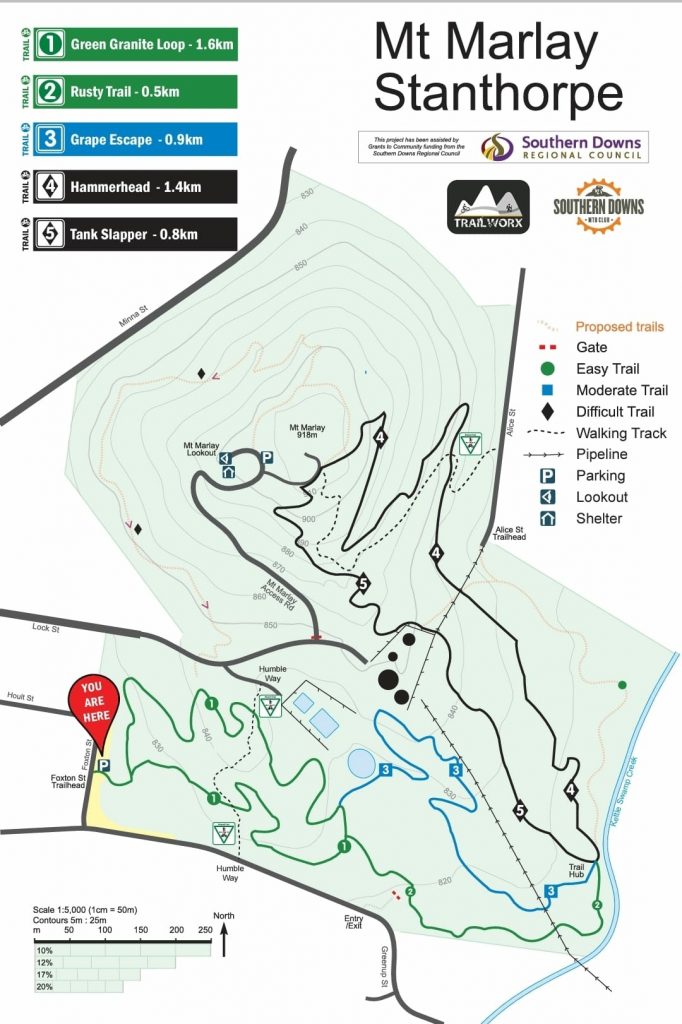
Donnelly’s Castle
Donnelly’s Castle is about a 20km drive to the north west of Stanthorpe. Access is from Castle Lane which comes off Donnelly’s Castle Road at Pozieres. Donnelly’s Castle is a natural formation of the locally occurring granite rocks and boulders which apparently served as a fabulous hideout for the bushranger known as Thunderbolt. You can really imagine the truth of this legend when you scramble up, around and through the rocks and peer into the distance from the lookout at the top. Kids and adults alike are bound to have a heap of fun here exploring the ‘castle’. I’d recommend close supervision of young children and keeping a keen eye out for snakes. Toilet facilities and picnic tables are available.
Girraween National Park
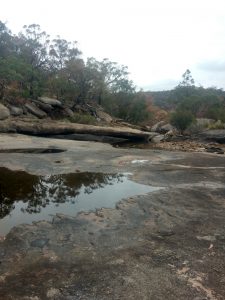
Girraween is about a half hour drive south of Stanthorpe. This unique national park is a landscape of stark contrasts. Girraween is famous for its abundant wildflowers and its rugged granite outcrops. The national park is also home to an extensive variety of birds, kangaroos, frogs, reptiles and other wildlife and is a popular place for day visitors and campers. As I write this article in January 2020, the camp grounds have been closed for some time due to ongoing drought, and the area has suffered from recent bushfires. As with all natural environments, Girraween changes with the seasons and I’ve loved watching the cycles of regeneration here over many years. There are signed bushwalks at Girraween ranging from 280metres to 11kms. Or simply explore the granite rock pools near the day use area. Toilet facilities, picnic tables and BBQs available.
You can read more about Girraween in my Great Backpacking Adventures series.
Sundown National Park
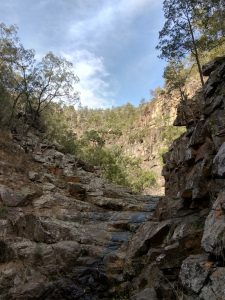
Sundown National Park can be accessed by most conventional vehicles from the south near Glenlyon Dam, or from the north off Texas Road and onto Nundubbermere Road. A third access point is along Sundown Road via Ballandean however once at the National Park the tracks become rough and steep so a 4WD is recommended along here. Sundown has several walks of varying lengths and difficulty as well as some camping areas. Look at the Sundown National Park website to plan your trip before heading out there as it is more remote than other regional parks with fewer facilities.
Walks in and around Allora and Goomburra
Dalrymple Creek Park
Dalrymple Creek Park is a shady park along the banks of Dalrymple Creek in Allora. The walking trail leads you along the banks of the creek with toilet facilities, picnic tables, BBQs, and play equipment along the way.
Goomburra Section, Main Range National Park
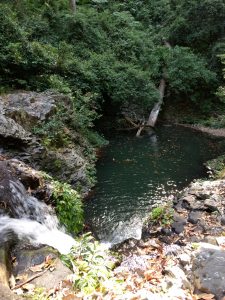
The Goomburra section of Main Range National Park is about 40kms east of Allora. Sections of the road into the National Park are unpaved and at times can be difficult for low clearance vehicles to navigate. After rain there can be several water crossings into the entrance of the park. A day use area and camping sites are available within the National Park as well as toilets and a variety of walking tracks that begin at the camping and day use areas, as well as other walking tracks that can be accessed from Lookout Road. Goomburra walks range from less than a kilometre to 12 kilometres long. All the walks are on unpaved surfaces and can include steep sections, natural obstacles (eg tree roots) and creek crossings. Spectacular views of the surrounding valleys and ranges can be seen from the high points of some of the walks.
Walks in and around Killarney
Queen Mary Falls, Main Range National Park
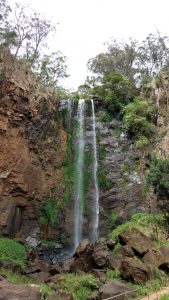
Queen Mary Falls is about 45kms east of Warwick. It offers a beautiful day use area with car parking, picnic tables, toilets, water and BBQs as well as a small kiosk across the road. The walk to The Falls is a 2 km circuit through the forest to the bottom of the Falls and back up again. The walk is steep in places, has stairs and is not suitable for prams or wheelchairs. The causeway at the bottom can be slippery.
If you’re looking for a shorter walk that’s suitable for prams, wander along to the two lookouts on either side of the Falls just a couple of hundred metres from the car park.
Browns Falls
Browns Falls is accessed from Spring Creek Road as you travel from Killarney towards Queen Mary Falls. Park your vehicle at Brown Falls Park where there is play equipment, picnic tables, BBQs and toilet facilities. Follow the track under the road and along the watercourse in an easterly direction for about 600 metres. The track is not well defined in places and you will need to scramble or rock hop along the watercourse. Take care as it can be very slippery when wet. The falls plunge into a beautiful waterhole surrounded by rock.
Walks near Maryvale
Cunningham’s Gap Section, Main Range National Park
Cunningham’s Gap is at the top of the Range on the Cunningham Highway about 90 minutes south west of Brisbane or 45 minutes east of Warwick. The closest town in the region is Maryvale only 15 minutes on the western side of the range.
There are two main access point to the walks in this section of the National park. At the top of the range known as “The Gap” there is a small car park and toilet facilities on the northern side of the highway with additional limited parking along the southern side of the highway. If you are crossing the highway to access the facilities or the walks on the other side, take great care and follow any signage that has been placed there for your safety as this is a very busy highway. Most of the walks are accessed from the northern side of the highway.
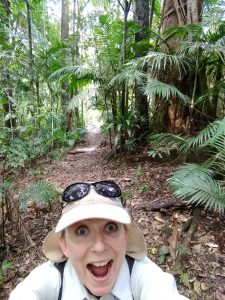
The alternative place to access The Gap walking tracks (and my personal favourite because it’s off the highway!) is via the West Gap Creek picnic area on the western side of The Gap. From Warwick, West Gap Creek picnic area is on your left just past “Stacey’s at the Gap” a couple of kilometres before you reach the The Gap. There are two small car parking areas, an extensive grassy picnic area, toilets, water, picnic tables and access to the Box Forest Walking Track which takes you about 2.5 kilometres through rainforest uphill to The Gap and the other walks. Walks here range from 1.6 kms to 12 kms long with varying levels of difficulty. Once again, check the National Parks site if you intend visiting as there were extensive bushfires through the Park in late 2019 resulting in closures of most walks throughout Main Range.
Some things to remember when walking in the Southern Downs!
There are simply SO MANY wonderful choices when it comes to walking in the Southern Downs. With so much natural beauty surrounded by a rural landscape, it’s the perfect place to relax and unwind. But safety always comes first! Here are a few reminders to help you have a truly fabulous time whilst minimising risks:
- Always prepare by doing your research before leaving home
- Check the National Parks ALERTS web page for closures and other advice, or contact the Rangers at the Park you plan to visit
- Take plenty of drinking water and food for everyone in your walking group as drinking water may not be available
- Wear comfortable closed shoes suitable for the terrain
- Protect yourself from the sun
- Follow signage and advice from authorities such as staying on track and taking all your rubbish with you
- Be First Aid aware and be well prepared including knowing how to manage snake risk and other injuries
- Mobile service may not be reliable in all areas
- Let someone know where you are going and what time you expect to be back
- Make sure you have plenty of fuel in your vehicle – some parks like Sundown National Park are a long way from fuel stations
For more information about walking in the Southern Downs
For more information about the parklands across the Southern Downs region, go to the Southern Downs Regional Council website or check with the Visitor Information Centres or the many tourism operators.
Let me know your favourite places and spaces for walking in the Southern Downs and further afield! And join us over on our community Facebook Group Outdoors is my Therapy where you can share ideas and inspiration no matter where you live or how you love to spend your time outside!

Discovering mountain biking as life’s ultimate parallel universe in her middle age, Kathryn Walton shares information and reflections in ‘Daisy Spoke’ that inform, inspire and empower women to a healthy and active lifestyle.




